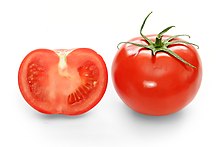Solanum lycopersicum
| Tomato | |
|---|---|
 |
|
| Cross-section and full view of a hothouse (greenhouse-grown) tomato | |
| Scientific classification | |
| Kingdom: | Plantae |
| (unranked): | Angiosperms |
| (unranked): | Eudicots |
| (unranked): | Asterids |
| Order: | Solanales |
| Family: | Solanaceae |
| Genus: | Solanum |
| Species: | S. lycopersicum |
| Binomial name | |
|
Solanum lycopersicum L. |
|
| Synonyms | |
|
Lycopersicon lycopersicum (L.) H. Karst. |
|
| Nutritional value per 100 g (3.5 oz) | |
|---|---|
| Energy | 74 kJ (18 kcal) |
|
3.9 g
|
|
| Sugars | 2.6 g |
| Dietary fiber | 1.2 g |
|
0.2 g
|
|
|
0.9 g
|
|
| Vitamins | |
| Vitamin A equiv. |
(5%)
42 μg
(4%)
449 μg123 μg
|
| Thiamine (B1) |
(3%)
0.037 mg |
| Niacin (B3) |
(4%)
0.594 mg |
| Vitamin B6 |
(6%)
0.08 mg |
| Vitamin C |
(17%)
14 mg |
| Vitamin E |
(4%)
0.54 mg |
| Vitamin K |
(8%)
7.9 μg |
| Minerals | |
| Magnesium |
(3%)
11 mg |
| Manganese |
(5%)
0.114 mg |
| Phosphorus |
(3%)
24 mg |
| Potassium |
(5%)
237 mg |
| Other constituents | |
| Water | 94.5 g |
| Lycopene | 2573 µg |
|
|
|
|
|
| Percentages are roughly approximated using US recommendations for adults. Source: USDA Nutrient Database |
|
| External identifiers for Solanum lycopersicum | |
|---|---|
| Encyclopedia of Life | 392557 |
| NCBI | 4081 |
| Also found in: | |
Lycopersicon lycopersicum (L.) H. Karst.
Lycopersicon esculentum Mill.
The tomato (see pronunciation) is the edible fruit of Solanum lycopersicum, commonly known as a tomato plant, which belongs to the nightshade family, Solanaceae.
The species originated in Central and South America. The Nahuatl (Aztec language) word tomatl gave rise to the Spanish word "tomate", from which the English word tomato originates.
Numerous varieties of tomato are widely grown in temperate climates across the world, with greenhouses allowing its production throughout the year and in cooler areas. The plants typically grow to 1–3 meters (3–10 ft) in height and have a weak stem that often sprawls over the ground and vines over other plants. It is a perennial in its native habitat, and grown as an annual in temperate climates. An average common tomato weighs approximately 100 grams (4 oz).
Its use as a food originated in Mexico, and spread throughout the world following the Spanish colonization of the Americas. Tomato is consumed in diverse ways, including raw, as an ingredient in many dishes, sauces, salads, and drinks. While tomatoes are botanically berry-type fruits, they are considered culinary vegetables, being ingredients of savory meals.
The word "tomato" comes from the Spanish tomate, which in turn comes from the Nahuatl word tomatl [ˈtomat͡ɬ]. It first appeared in print in 1595.
...
Wikipedia
